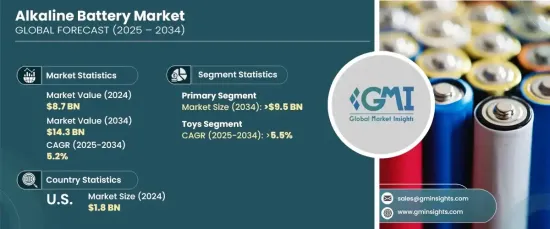
세계의 알칼리 배터리 시장은 2024년에 87억 달러에 달하며, 2025-2034년에 5.2%의 CAGR이 예측되며, 꾸준한 성장이 전망되고 있습니다. 높은 에너지 밀도, 신뢰성, 긴 수명으로 유명한 일회용 배터리는 수산화칼륨과 같은 알칼리성 전해액을 사용하여 금속 아연과 이산화망간의 화학반응을 통해 전력을 생산합니다. 이 특징적인 기능으로 인해 산성 전해질을 사용하는 배터리와 차별화되어 다양한 용도에서 선호되는 선택이 되고 있습니다.

사용자 친화적이고 특별한 취급이 필요 없으며, 비용 효율적이고 유지보수가 필요 없는 배터리에 대한 시장 수요가 급증하고 있습니다. 수은과 같은 유해 물질을 제거한 친환경 알카라인 배터리 개발에 대한 투자가 기술 혁신을 촉진하고 있습니다. 이러한 발전은 환경에 대한 관심 증가와 규제 기준의 발전과 일치하여, 알카라인 배터리의 매력과 시장 경쟁력을 높이고 있습니다.
| 시장 범위 | |
|---|---|
| 시작연도 | 2024년 |
| 예측연도 | 2025-2034년 |
| 시작 금액 | 87억 달러 |
| 예상 금액 | 143억 달러 |
| CAGR | 5.2% |
1차 제품 유형은 2034년까지 95억 달러 규모 시장을 창출할 것으로 예상되며, 충전이나 추가 장비가 필요 없는 1회용 배터리의 인기 상승이 그 원동력이 되고 있습니다. 저렴하고 편리한 전원 솔루션을 찾는 소비자, 특히 잦은 배터리 교체가 필요한 기기에 대한 수요가 이러한 추세를 주도하고 있습니다. 충전식 대체품에 비해 초기 비용이 저렴하다는 점도 이러한 배터리의 보급에 더욱 힘을 실어주고 있습니다.
용도별로는 완구 부문은 2034년까지 연평균 5.5%의 견고한 성장이 예상됩니다. 전자 장난감과 휴대용 게임기에 전력을 공급하기 위한 고에너지 밀도 배터리에 대한 수요가 증가하면서 수요를 촉진하고 있습니다. 알카라인 배터리는 저렴한 가격, 내구성, 긴 수명으로 인해 제조업체들이 선호하고 있으며, 전력 집약형 용도에 이상적인 선택이 되고 있습니다. 장난감 시장에서 알카라인 배터리에 대한 의존도가 높아짐에 따라 향후 수년간 큰 성장 기회를 창출할 것으로 예상됩니다.
미국 알카라인 배터리 시장은 배터리 재활용에 대한 인식이 높아지고 환경 규제가 강화됨에 따라 2034년까지 30억 달러에 달할 것으로 예상됩니다. 제조업체들은 지속가능한 솔루션에 집중하면서 알카라인 배터리의 매력을 높이고 있습니다. 신뢰할 수 있고 저렴한 에너지원에 대한 수요 증가와 CE(Consumer Electronics) 산업의 급속한 확장은 알카라인 배터리의 채택을 촉진하고 있습니다. 알카라인 건전지는 신뢰할 수 있는 성능과 긴 보관 기간으로 인해 다양한 가정용 및 산업용 용도에서 실용적인 선택이 되어 시장 성장을 더욱 강화하고 있습니다.
The Global Alkaline Battery Market reached USD 8.7 billion in 2024 and is poised for steady growth, with a projected CAGR of 5.2% between 2025 and 2034. These disposable batteries, known for their high energy density, reliability, and extended shelf life, generate power through a chemical reaction between zinc metal and manganese dioxide, utilizing an alkaline electrolyte like potassium hydroxide. This distinctive feature sets them apart from batteries with acidic electrolytes, making them a preferred choice across diverse applications.

Market demand is surging for cost-effective, maintenance-free batteries that are user-friendly and require no specialized handling. Investments in the development of eco-friendly alkaline batteries, which eliminate hazardous materials such as mercury, are driving innovation. These advancements align with growing environmental concerns and evolving regulatory standards, enhancing their appeal and market competitiveness.
| Market Scope | |
|---|---|
| Start Year | 2024 |
| Forecast Year | 2025-2034 |
| Start Value | $8.7 Billion |
| Forecast Value | $14.3 Billion |
| CAGR | 5.2% |
The primary product type segment is anticipated to generate USD 9.5 billion by 2034, fueled by the growing popularity of single-use, ready-to-use batteries that require no charging or additional equipment. Consumers seeking affordable and convenient power solutions, especially for devices needing frequent battery replacements, are driving this trend. The lower initial cost of these batteries compared to rechargeable alternatives further solidifies their widespread adoption.
In terms of application, the toys segment is forecasted to grow at a robust CAGR of 5.5% through 2034. The increasing need for high-energy-density batteries to power electronic toys and portable gaming units is boosting demand. Alkaline batteries are favored by manufacturers for their affordability, durability, and long lifespan, making them an ideal choice for power-intensive applications. This growing reliance on alkaline batteries in the toys market is expected to create substantial growth opportunities over the coming years.
The U.S. alkaline battery market is projected to reach USD 3 billion by 2034, driven by increasing awareness of battery recycling and stricter environmental regulations. Manufacturers are focusing on sustainable solutions, enhancing the appeal of alkaline batteries. The growing demand for reliable and affordable energy sources, coupled with the rapid expansion of the consumer electronics industry, is bolstering adoption. With their dependable performance and long shelf life, alkaline batteries remain a practical choice for various household and industrial applications, further reinforcing market growth.